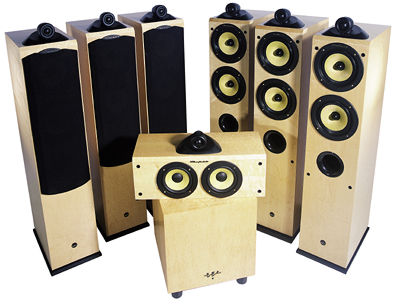Wharfedale Pacific surround speaker system

The units I reviewed were from Wharfedale's Pacific series "Limited Edition." The Limited Edition differs from the standard only in its gorgeous bird's-eye maple finish. This veneer is so fine, the cabinet corners trimmed so well, that I thought they were vinyl—until I noticed that the speakers came in matched pairs, and the wood grain matched perfectly on the same facing sides. That elevates the Pacific LE speakers into the furniture realm—where they'll probably please even the most critical interior decorator. The bird's-eye finish was most apparent on the subwoofer—its driver fires at the floor, so all of its visible surfaces displayed the whorls and circles unique to this grain. The Pacifics were wonderful additions to my otherwise all-black studio.
Dissection
The woofers and midranges of the Pacific speakers are made of a Kevlar weave, which reportedly has a very good ratio of stiffness to mass. In an attempt to reduce front-baffle diffraction, the cloth-dome tweeter is mounted in a separate pod perched atop the cabinet—even in the center-channel model. The tweeter can be rotated to direct its output, which can work like a level control when it's aimed toward or away from the main listening area. This also makes it easier to reduce wall reflections in an untreated room.
Less obvious features are the crossover and internal cabinet design. The main enclosures are well-braced, with a front panel about 50% thicker than the sides and rears. This helps to reduce the amount of energy loaded into the box by the drivers. The crossover is a Zobel design that helps keep the impedance response even throughout the frequency range. This should make the speakers relatively easy for an amplifier to drive.
I used six Pi-40 tower speakers for the fronts, sides, and rears of my 7.1-channel system. The speaker stands a proud 43 inches tall, which places the exposed tweeter just out of reach of most "terrible-twos" members of the species. Teaching slightly larger, older humans to not poke the inviting soft-dome tweeter was one experiment I couldn't conduct—none of my friends in L.A. have children young enough to wreak such horrible torture on speaker drive-units.
Woof Woof?
The Pi-40 tower has two identical-looking 6-inch drivers in the cabinet beneath its tweeter pod. After I'd carefully disassembled one of the speakers, I discovered that the drivers are actually different. The woofer cone is slightly weightier, and produced a deeper thunk from a finger-tap. The crossover point between these units is set at 60Hz; the woofer is there to simply augment the midrange driver's nearly full-range performance. I did not set my surround processor to Small, as the 80Hz crossover would eliminate the output of this bass unit.
The woofer is mounted in a ported subenclosure, while the midrange enclosure is sealed. Both of these enclosures contain 1-inch fiberfill to reduce internal acoustic reflections. The internal bracing and construction were very impressive—almost too good for a speaker at this price. The connections on the back were the same as on the Audio Pro Black Diamond speakers (reviewed in the September 2001 issue): two sets of 5-way binding posts allowing for biwiring or biamping, if desired.
And the Others . . .
The Pi-Center speaker has the same tweeter assembly as the Pi-40, mated to two 51/4-inch Kevlar mid/woofers in a ported enclosure. But the Pi-Center has only a single set of input terminals and is not biwirable. When I inquired about this to our contacts at Wharfedale, they explained that the benefits of biwiring are at the frequency extremes, and that the center channel wasn't as critical as the mains. This indicates a lack of understanding of movie soundtracks: the center channel works harder than anything else in the system, except perhaps the subwoofer. I begged them to update the center-channel speaker to allow biwiring.






























































